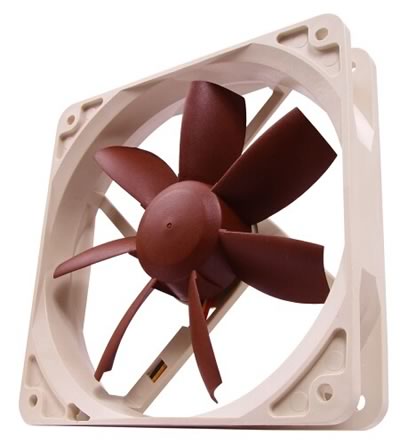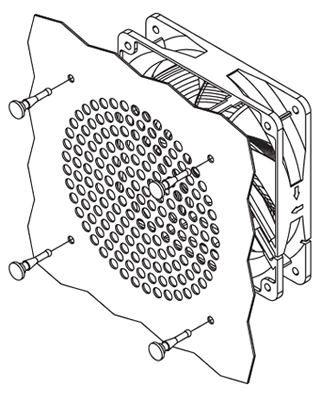1. Introduction
 Many users after buying a brand new computer, look for ways to optimize its performance or enhance its appearance. Among those are noise reduction and efficient cooling, two very hot subjects that also occupy many forum threads and produce a variety of articles on thousands of web sites.
Many users after buying a brand new computer, look for ways to optimize its performance or enhance its appearance. Among those are noise reduction and efficient cooling, two very hot subjects that also occupy many forum threads and produce a variety of articles on thousands of web sites.
The Holy Grail for many high end users has been to find a rotating fan with zero noise level and at the same time produce enough airflow to keep the case and its components cool.
The solution for both cases may come from Noctua, an Austrian company that manufactures cooling products for computers. In this review, we are going to examine two of their latest and most silent case fans.
Noctua provided us with their 12cm (NF-S12) and 8cm (NF-R8) case fans. Let's take a look at the specifications of these two fans.

|
NF-S12 |
NF-R8 |
|
Normal |
U.L.N.A |
Normal |
L.N.A. |
U.L.N.A. |
| Bearing |
SSO-Bearing |
SSO-Bearing |
| Blade Geometry |
Straight-Blade-Design |
Raised-Blade-Design |
| RPM |
1200 |
600 |
1800 |
1300 |
800 |
| Airflow (m3/h) |
81 |
41 |
53 |
39 |
26 |
| Acoustical Noise (db) |
17 |
< 6 |
17 |
10 |
7 |
| Input Power (Watt) |
1,44 |
1,32 |
| Input Current (A) |
0,12 |
0,11 |
| Voltage Range (Volt) |
4-13 |
4-13 |
| MTBF |
>150.000 h |
> 150.000 h |
The fans have sound-optimized blade geometry and profile, developed by the Austrian Institute for Heat-Transmission and Fan Technology, with self-stabilising oil-pressure bearings (SSO bearing) that makes them produce less noise and greater life-span than the traditional ball-bearing fans.
The NF-S12 uses Straight Blade Design while the NF-R8 uses Raised-Blade-Design, both patented by Noctua.
- Packaging
Both fans came in retail packaging with Ultra Low Noise Adaptor, 4 silicon vibration compensators, 3:4-pin adaptor and 4 typical fan screws. The NF-R8 also comes with a Low Noise Adaptor. These adaptors (L.N.A. and U.L.N.A.) are simply short power extensions cables (to the right of the box in the picture below), that have a resistor in-line to reduce the current flowing to the fan and hence reduce the fan's rotation speed.


2. Design and Installation
These also fans stand out because of their retro colouring. They consist of a dark brown fan with a creamy white casing.


- Installation
Installing the fans with the vibration compensators proved to be not an easy task because the compensators are so flexible. In order to install them properly, you have to pull the vibration compensators through the mounting holes on the PC case.

Then line up the fan with the vibration compensators and pull them through the mounting holes of the fan.

3. Tests and Conclusion
The 12cm model came with only the U.L.N.A. adaptor while the 8cm model also included a L.N.A. adaptor. It would be better though if they had a potentiometer to regulate the RPM instead of adaptors.
The NF-S12 works at 2 speeds (1200/600 rpm) and at both settings, the fan provides very good airflow. The NF-R8 has 3 speeds (1800/1300/800 rpm) and only the two first speeds produce adequate results.
We installed them on the back of our PC case, below the power supply and compared to the standard ball bearing fans (12 and 8 cm respectively), they performed much better with regards to noise level and airflow. They are very quiet, even without using any of the low noise adaptors. Their operation proved to be barely noticeable. With the case closed, the only noticable noise produced, was from the CPU cooler and the hard disk.
The fans run at their nominal speeds with a variation of +5-10% which is normal. The cables are long enough so there should be no problem finding a connection anywhere on the motherboard to plug in, and if the motherboard doesn't provide a spare 3-pin fan connection, you can use the 3:4-pin adaptor and plug it to a molex connector. The only drawback here is that you can't monitor the fan's speed.
- Conclusion
Both products are the most silent and efficient case fans we've ever reviewed. They don't have the bells and whistles other similar products have, but they bear cutting edge technology.
These fans are aimed at consumers who know what they want and want it silently.

Pros
- Great retail packaging
- Vibration Compensators
- SSO Bearing
- Deadly Silent
- 6 year warranty
Cons
- Adaptors instead of potentiometer or switches for RPM regulation
- Difficult to install the vibration compensators